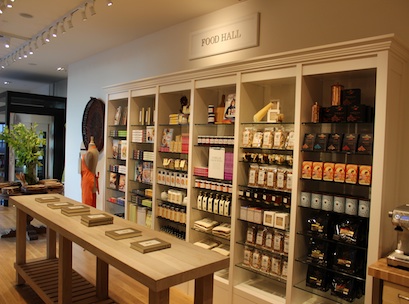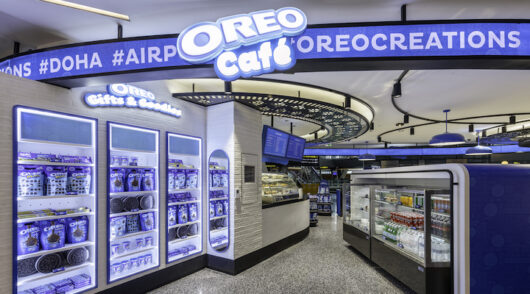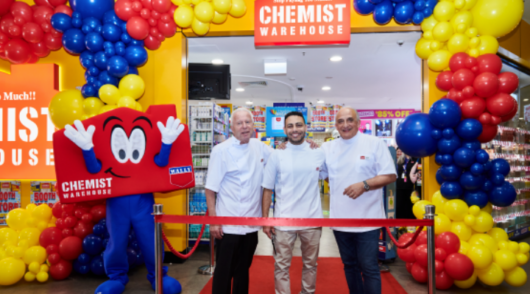He brought Balsamic vinegar and the cow creamer to America, and now, Chuck Williams, founder of Williams-Sonoma is bringing four new brands and a new standard of service to Australia. 
At 97, his impact on the retail market worldwide remains, and the four brands he fostered, Williams-Sonoma, Pottery Barn, Pottery Barn Kids, and West Elm, have now made their way to local shores. Launching in May, the four brands occupy a 2040sqm space on Oxford St, Bondi Junction, adjacent to Westfield, and are set to shake up the Australian market, with any luck, pushing domestic retailers to higher levels of service and design.
Founded in 1956 as a cookware store in the US in the Californian suburb of Sonoma, there are now 255 of the kitchen-centric stores around the world.
The Pottery Barn concept was purchased in 1986 and now boasts 180 stores, while West Elm, the baby of company, began just 10 years ago and has since amassed 48 stores in North America in addition to its Bondi Junction presence. They are the first of what is expected to be a much larger national presence, with a second West Elm store confirmed to open on Melbourne’s Chapel St later this year.

No expense has been spared on the fitout and VM of the stores, with Craig Nomura, VP of global development telling Inside Retail, “fitout is one thing that we do that we put a lot of time and effort into because our store experience is so important to us to express our brand and our lifestyle”.
“We definitely don’t shortchange on the fitouts,” Nomura says.
The facade of the four stores reflect this, the windows boasting decals of the brands’ heritage, and their wooden cladding a distinctive change from the bland brick and windowed shopfronts surrounding it on the slightly run-down Oxford St Mall.
“We were looking in the malls,” says Nomura, “but we thought of a street presence because they are lifestyle brands, so it worked out perfectly. It was just having the right real estate at the right time.” Although smaller in size than their US counterparts, each of the four stores reflect the culture of each of the brands, with each store distinctively different from one another.
One thing key to the Australian launch is it’s omni-channel approach. The company is most proud to be launching with all three of its channels available to Australians – bricks and mortar, online, and catalogue.
“One of the things we were looking at first here, was the size of our stores. They’re dramatically smaller. A West Elm store in the US is probably twice the size.
“Our issue was, how do we get the right assortment in here with the limited space? But with our e-commerce capabilities we can add more product online, so they can go into the store, experience that, then the e-commerce supplements that, and we ship everything everywhere in Australia.”
Williams-Sonoma

The new Australian presence represents not just a first for the Australian market, it marks two other world firsts for the group – the first location to house all four brands, and Williams-Sonoma’s first culinary school. Located at the the rear of the store, the school builds on Williams-Sonoma’s ingrained culture of inshore cooking and cookware demonstrations, taking the concept to a new level of interactivity.
The school is capable of training up to 12 students at a time, and features a central work bench and six work stations in addition to a scullery, pantry, and wine tasting area.
To add to the theatrical aspect Williams-Sonoma stores are so well known for, classes will also be filmed and broadcast to different sides of the building and live-streamed to different sides of the building.
A team of Williams-Sonoma’s own chefs will host the classes with contributions from guest chefs. Though on a smaller scale, the William-Sonoma store is much like that you would find in the US – stocking branded and own brand cookware, an exhaustive selection of knives and cookery tools, tabletop accessories, glassware, crockery, and electrics.
A small food hall stocks a selected range of food, including more artisan products by some local vendors as well as traditional American fare such as whoopie pies.
West Elm
West Elm, which fronts both Grosvenor St and the Oxford St Mall, has the biggest street presence, emblazoned with visual merchandising reminding shoppers of its heritage – ‘From Brooklyn to Bondi’.
West Elm is the newest of the four brands, having launched in 2003. There are now 49 stores, Bondi Junction being the first outside of north America. Stores are based on a New York loft style, with personalisation the key instore. “A lot of this is inspired by New York lofts and urban living so you’ll see smaller sized furniture and slightly lower price points than Pottery Barn,” says Nomura.
Textiles are accessories important to the West Elm brand, all designed in Brooklyn. The brand aims to target a younger consumer with plenty of colour, prints, and fashion. Local collaborations are also a key aspect of West Elm, with collections by small artisans regularly featured. Already, West Elm has engaged the services of local Sydney artists, Maricor and Maricar Manalo, to design a welcome sign featured at the entry to the store as well as a tote for giveaways in the first days of opening.

The lynchpin of both the West Elm and Pottery Barn stores is their unique design studios. A free home design and interior decorating service, professional instore stylists are able to assist shoppers with styling a home.
The service can be carried out instore, over the phone, or at the customer’s home, and allows to-scale planning of a space for interior decorating purposes and parties. Large screens punctuate the design spaces of Pottery Barn and West Elm, where customers are able to sit with a design director to mix and match furniture and accessories from the stores’ ranges.
And when the designing is done, it doesn’t end there. Stylists will finish the job themselves, visiting a home to install the product and hang and steam the curtains, even taking out the rubbish.
It’s a style of service not seen before in Australia by a mid-priced retailer, and is sure to shake up the market. West Elm also uses configuring tools to help customers best configure their bed and bedding to their home and bedroom. “The area where West Elm really shines is their bedding,” Leigh Oshirak, VP of PR and marketing for the Williams-Sonoma group told Inside Retail Magazine.

“We’ve been able to deliver great value and fashion. We layer the bed, which is very quintessential to the brand, really mixing and matching the textiles and the texture so you get that cosy overstuffed bed,” Oshirak says. “Textiles, padding, and colour are hallmarks of West Elm.”
Pottery Barn
Pottery Barn and Pottery Barn Kids, while having separate entrances and spaces, are largely intertwined, with customers able to walk between the two concepts with ease.
Oshirak says the difference between West Elm and Pottery Barn is that Pottery Barn is “the casual, comfortable slice of Americana”.
“Pottery Barn has articulated that style a little bit better. It’s very recognisable when you see it – it’s that rolled arm sofa, and it’s a little more stuffed and layered than West Elm,” says Oshirak.
“The difference is also the size of the pieces and the colours and stains of the woods. The contemporary is pushed a lot harder in West Elm.”

At the heart of the Pottery Barn space is once again its design services. One of the other fundamental service offerings of Pottery Barn is its complementary design classes held on weekends.
Classes on topics such as coastal style are taught, with all products used in the demonstration available for 10 per cent off.
Pottery Barn Kids
Noruma says separate side by side entries to Pottery Barn and Pottery Barn Kids and the merging of the two concepts is unique to the Australian store.
The majority of the Pottery Barn Kids site is housed on the second floor, accessible by a somewhat grand staircase which punctuates the downstairs floorplate.
The Pottery Barn Kids store is virtually split in two, with older children’s merchandise towards the front, and Pottery Barn Baby occupying the rear of the space.
Here customers will find the company’s monogramming station, which allows for personalised embroidery of a host of products from towels, quilt covers, and blankets, to pillowcases and child-sized chairs.
Baby gift wrapping is also available at Pottery Barn Baby in addition to the furniture, toys, manchester, books, and baby bags.

One of the most popular engagements for children at the Pottery Barn Kids store is its doll tea parties, where parents, grandparents, and carers have the opportunity to bring in their children and dolls (also sold instore) for tea parties.
Says Oshirak: “We’re really about classic toys and imaginative play. We’re not really an electronic type of brand, we’re quite classical and about inspiring the imagination.”
This story originally appeared in Inside Retail Magazine. The August/September issue, featuring exclusive coverage of the 2013 Westfield World Retail Study Tour is available now. For more information, click here.





